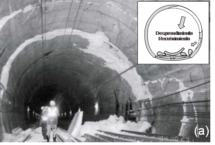Seismic risk of mined tunnels
Recent earthquakes worldwide have caused major direct losses due to damaged infrastructure. The 2010 Maule earthquake alone generated losses over 30 billion USD, and costs skyrocketed for construction, labor, and insurance premiums; however, tunnels and buried pipelines built on stiff soils performed very well, and no major damages were reported. A similar response was observed in the LA Metro (Northridge earthquake 1994), Athens Metro (Athens earthquake 1999), and Taipei Metro (Chi-Chi earthquake 2002). On the other hand, and contrary to the general notion of the seismic safety of tunnels built on stiff soil, the latest experimental results have shown that these tunnels are indeed highly vulnerable systems during strong earthquakes. This apparent discrepancy about tunnel performance is the focus of this research.
Despite the recent advances in ground motion characterization and the sophistication of current numerical tools for evaluating the tunnel response, quantifying the seismically induced damage and losses is still cumbersome. Moreover, current design practices provide no estimates of the tunnel performance variability or the rate of occurrence of damage parameters, which makes the seismic loss assessment yet more difficult. The goal of this research is to estimate damage and loss fragility functions for a circular mined tunnel in stiff soil deposits, and test the main working hypothesis “Mined tunnels in stiff soil designed for static loads can withstand severe ground motions without significant damage”. For this purpose, and to constrain the number of variables involved, the study will focus on circular dual track tunnel in stiff soils, excluding any form of ground failure.
To test the research hypothesis, the study will use a performance based Approach to compute seismically induced damage and losses for two tunnel designs: a code conforming tunnel designed to resist static and seismic loads, and a hypothetical tunnel designed only for static loads. The conjecture here is that if a mined tunnel in stiff soil is properly designed for static loads (i.e., using adequate factors of safety for gravity and construction loads), then no additional seismic forces need to be specified. This result can be translated to reduced construction and insurance costs at no expense of safety, saving taxpayers millions of dollars. Furthermore, this study will help to identify the variables that drive the damage generation in tunnels and the influence (or lack thereof) of seismic design provisions in the expected losses.
FONDECYT INICIACIÓN – PI: Gabriel Candia
Facultad de Ingeniería Civil, Universidad del Desarrollo

Failure of tunnel lining during the Niigataken-Chuetsu del 2004

Finite element mesh of circular mined tunnels in stiff sand modeled in OpenSees
LINKS
